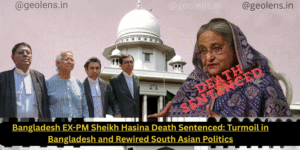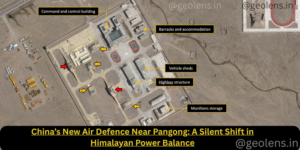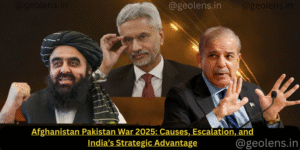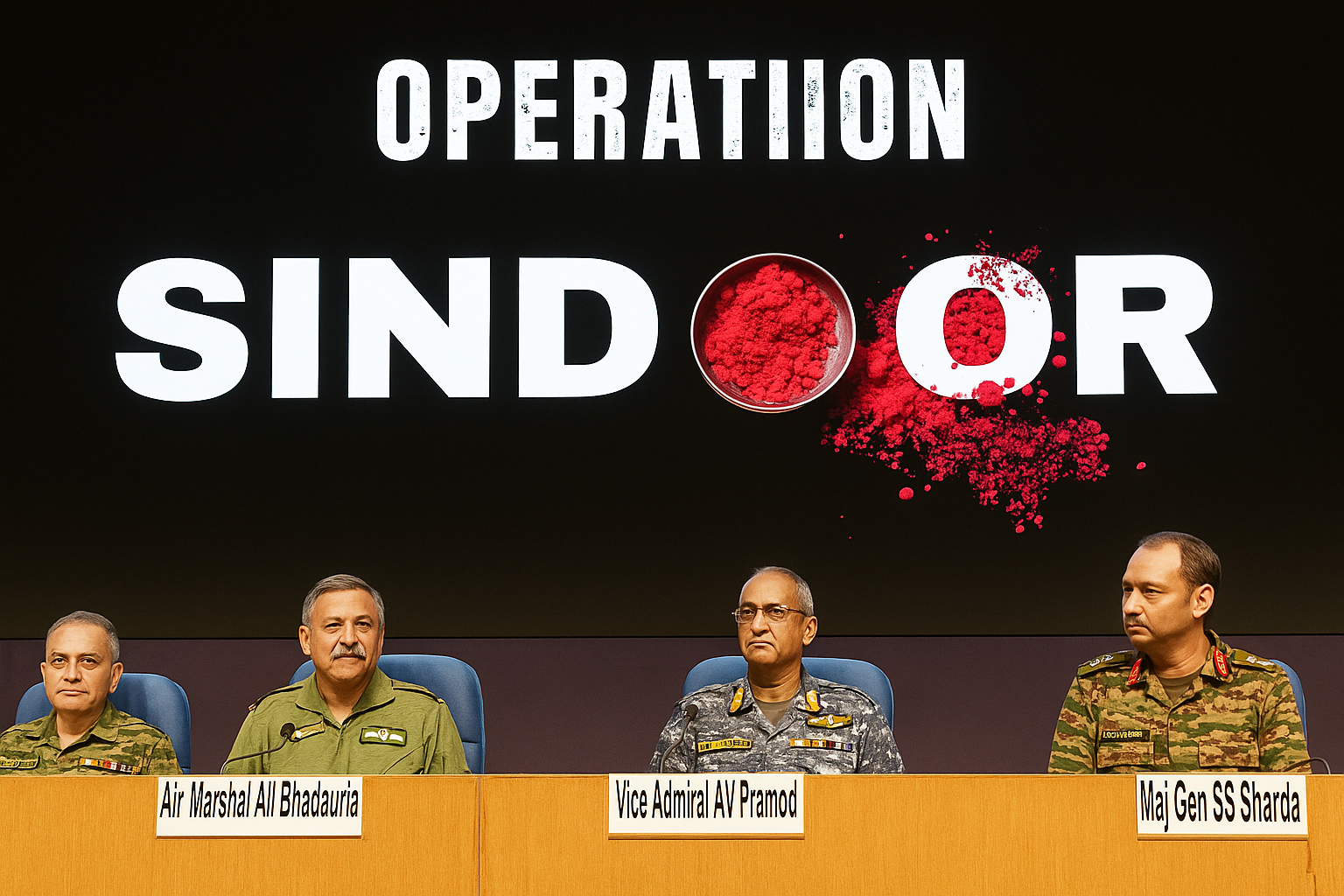Table of Contents
In a landmark move aimed at revamping India’s educational narrative, the Ministry of Education has announced that Operation Sindoor, Mission LiFE, and India’s recent space missions—Chandrayaan, Aditya L1, and Shubhanshu Shukla’s journey to the International Space Station (ISS)—will soon be featured across NCERT textbooks for Classes 3 to 12. This update marks a bold step towards integrating real-time national achievements into classroom learning, inspiring students with contemporary stories of courage, innovation, and sustainability.
The Announcement: Real Heroes, Real Missions in Real in NCERT
New Delhi, July 2025 – The Indian government has taken a forward-thinking step in reshaping the school curriculum. According to an official statement by the Ministry of Education, NCERT will soon introduce chapters featuring Operation Sindoor, Mission LiFE, and major ISRO-led missions—Chandrayaan, Aditya L1, and astronaut Shubhanshu Shukla’s ISS mission—into textbooks from primary to senior secondary level.
This inclusion seeks to bring relevance to learning, bridge the gap between classroom knowledge and national achievements, and instill in young minds a sense of national pride and scientific curiosity.
India's Missions of Bravery and Science : Operation Sindoor & more in NCERT
From bold military operations to groundbreaking space explorations, India has consistently demonstrated its growing strength and vision on the global stage. These missions are not only milestones in defense and science but also symbols of national courage, technological advancement, and strategic thinking.
Understanding them offers students a deeper appreciation of the nation’s capabilities and aspirations.
Operation Sindoor: India’s deadliest Response to Pahalgam Terror Attack in early 2025 following a deadly terrorist attack in Pahalgam, Jammu & Kashmir. In a swift and decisive counter-terror operation, Indian Armed Forces neutralized the threat within hours, showcasing precise coordination between intelligence, ground forces, and aerial support.
The name “Sindoor” symbolizes sacrifice, valor, and the blood of martyrs that protects the motherland. The operation was not just about military action—it became a symbol of national resilience and tactical brilliance.
Chandrayaan: India’s Lunar Leap
India’s Chandrayaan-3 mission successfully landed on the Moon’s south pole in 2023, making India the first nation to do so. This mission demonstrated India’s growing prowess in space technology, achieving complex objectives at a fraction of the global cost. The success of Chandrayaan not only elevated ISRO’s international status but also ignited interest in space exploration among Indian youth.
Aditya L1: Touching the Sun
Launched in the same year, Aditya L1 is India’s first dedicated mission to study the Sun. It now orbits around Lagrange Point 1, continuously observing solar phenomena like flares, winds, and storms that can impact Earth’s climate and communications. This mission is a monumental step toward understanding space weather and enhancing satellite protection.
Shubhanshu Shukla’s Historic ISS Mission In 2025:
Shubhanshu Shukla made history by becoming the first Indian astronaut in decades to reach the International Space Station under an Indo-US collaboration. His mission focused on conducting microgravity experiments, space medicine, and future Mars-mission research. His journey represents India’s entry into a new phase of manned space exploration.
Why the Government Decided To Add In NCERT
The decision to include Operation Sindoor and recent space missions in the NCERT curriculum isn’t just an educational update—it’s a strategic move to reshape how young Indians connect with their nation’s present-day achievements.
By integrating real events into textbooks, the government aims to make learning more relevant, foster national pride, and prepare students to think critically about India’s evolving role in defense, science, and global leadership.
This curriculum update is rooted in four key motivations:
Educational Modernization: Move beyond rote learning by incorporating recent real-life events into the academic framework. Ignite Young Minds: Motivate students by showcasing contemporary heroes and India’s achievements. Cultural & Scientific Awareness: Build an integrated understanding of India’s strategic, environmental, and scientific developments. Nation-Building through Knowledge: Cultivate a generation that is aware, proud, and globally competitive.
Positive Impact: Transformation in Young Minds
Introducing real-life national achievements into the classroom has the power to do more than just inform—it can inspire. By learning about Operation Sindoor, Chandrayaan, and other modern missions, students begin to see the relevance of their education in shaping the world around them. This shift will spark curiosity, fuel ambition, and build a generation that thinks critically, dreams big, and believes in India’s potential.
Real-World Inspiration: Learning about actual military operations and space missions makes abstract subjects like science and civics more tangible and exciting. Career Aspiration Booster: Exposure to stories of astronauts, scientists, and soldiers encourages students to dream big and explore careers in defense, science, and innovation. National Identity & Pride: Understanding India’s efforts in space, defense, and environmental sustainability fosters a deeper connection with national values. Critical Thinking & Curiosity: Students begin to ask questions about technology, geopolitics, climate, and science—creating a generation of thinkers and doers.
A New Chapter in India’s Self-Awareness Journey
This curriculum reform is symbolic of India’s rising confidence as a knowledge-driven, self-reliant nation. For decades, Indian textbooks focused heavily on colonial history and foreign narratives. The inclusion of modern Indian milestones represents a shift from dependency to leadership.
From the battlefield of Pahalgam to the surface of the Moon and the Sun’s orbit, India is crafting a new story—and now, its children will learn it not from foreign documentaries but from their own schoolbooks. This is not just about education—it’s about awakening self-awareness, national pride, and futuristic ambition.
FAQs
- What is Operation Sindoor?
Operation Sindoor was a swift and decisive counter-terror military action by India in response to the terror attack in Pahalgam in April 2025. It targeted major terror infrastructure across Pakistan and Pakistan-occupied Jammu & Kashmir. - Why was the operation named “Sindoor”?
The name symbolises honour and respect for the widows of the terror attack victims. It reflects India’s commitment to protect its people and the sacrifices made by families of soldiers and civilians. - How is Operation Sindoor being introduced into the school syllabus?
NCERT has prepared special modules for Classes 3–12 featuring case studies, maps, visuals, and teacher-student dialogues to make students understand the significance of this modern counter-terror operation. - What message does Operation Sindoor convey to students?
It highlights national unity, decisive leadership, technological advancement in defence, and India’s readiness to counter terrorism without hesitation. - What role did India’s defence capabilities play in the operation?
The operation demonstrated strong coordination between the Army, Navy and Air Force, indigenous technological capabilities, intelligence precision, and the ability to strike without civilian harm. - How many terror camps were destroyed during Operation Sindoor?
Nine key terror bases were neutralised out of the twenty-one shortlisted targets, including major hubs directing attacks against India.
- Why is including Operation Sindoor in school education significant?
It introduces students to national security awareness, real-world strategic challenges, and the importance of courage and unity in protecting the nation. - Does the module address Pakistan’s role in the attack?
Yes. It clearly highlights that the Pahalgam attack was planned and supported by Pakistan’s leadership and executed through its terror networks.
People Also Ask (PPA)
- What triggered India to launch Operation Sindoor?
The operation was launched after a deadly terror attack in Pahalgam where innocent civilians and security personnel lost their lives. - Is studying Operation Sindoor mandatory in schools?
The content is currently introduced as supplementary learning material, allowing schools to integrate it to strengthen national security education. - Did India avoid civilian casualties during Operation Sindoor?
Yes. The mission was executed with careful target selection and precision strikes to ensure only terror infrastructure was hit. - How will Operation Sindoor help students understand national defence?
It teaches real examples of India’s military coordination, technological advancement, and decision-making under crisis to inspire informed citizenship. - How long did the operation take to execute?
The main strike segments were completed in just 22 minutes, showcasing exceptional planning and efficiency. - What symbolism is connected with the operation’s name?
The term “Sindoor” represents the sacrifices of families affected by terrorism and reinforces a message of national solidarity. - Is Operation Sindoor linked with India’s modern defence achievements?
Yes. It is presented along with India’s progress in military technology, space capabilities, and strategic deterrence. - How does Operation Sindoor compare with previous Indian operations?
It marks a shift toward integrated, precise, and technology-driven retaliation rather than prolonged conventional conflict.
Conclusion
The inclusion of Operation Sindoor, Chandrayaan, Aditya L1, Shubhanshu Shukla’s ISS mission, and Mission LiFE in NCERT textbooks is a visionary step. It combines patriotism with science, history with progress, and textbooks with reality. As millions of Indian students turn the pages of their new books, they won’t just read about history—they’ll read about themselves and the India they are building.
Know more about the real Heros of Kargil war 1999 below. Let’s Honore the valor of India`s Bravehearts.
Kargil Vijay Diwas 2025: Honoring the Valor of India’s Bravehearts|26th July 1999

Pratik Kondawale
Strategist | Indian Defence & Global Affairs
Founder of GeoLens.in, Pratik writes in-depth analysis on India’s defence strategy, military tech, and global power shifts delivering sharp insights through an Indian lens.

Tejas Crash at Dubai Air Show 2025 — A Tragedy, A Lesson, and A Call for Reform
The Tejas crash at the Dubai Air Show turned a moment of national pride into sudden heartbreak when Wing Commander Syal lost his life. This article unpacks the events of that day, explains why the Tejas crash matters for India’s defense readiness, and outlines the practical lessons and reforms needed to ensure the program recovers stronger. It also honors the pilot’s sacrifice and shows how the Tejas crash can become a catalyst for accountability, safer engineering, and faster delivery of operational jets.

Bangladesh EX-PM Sheikh Hasina Death Sentenced: Turmoil in Bangladesh and Rewired South Asian Politics
The Sheikh Hasina death sentenced verdict has detonated one of the most explosive political crises in Bangladesh’s modern history. Delivered in absentia by the International Crimes Tribunal, the ruling blames the former prime minister for orchestrating widespread state violence during the 2024 student protests. The decision has dismantled the Awami League’s long-standing dominance, pushed Bangladesh into a volatile power vacuum, and placed India in the middle of a diplomatic standoff. As questions about justice, political motivation, and regional stability collide, the fallout of this verdict is reshaping South Asian geopolitics in real time.

China with New Air Defence Near Pangong: A Silent Shift in Himalayan Power Balance
China’s new air defence near Pangong marks a major strategic escalation in the Himalayas. Satellite imagery reveals advanced HQ-9 missile systems, radar units, and fortified shelters aimed at asserting Chinese air dominance over eastern Ladakh. This development not only alters the regional military balance but also raises critical questions about India’s preparedness, response strategy, and the long-term implications for border security and geopolitical stability in South Asia.

Afghanistan Pakistan War 2025: Causes, Escalation, and India’s Strategic Advantage
The recent Afghanistan Pakistan war marks a dangerous escalation from border tensions to open state-level confrontation. What began with Pakistani airstrikes inside Afghan territory quickly spiraled into fierce Afghan retaliation, signaling Kabul’s newfound military assertiveness. This conflict exposes Pakistan’s growing vulnerabilities—diplomatic isolation, two-front pressure, and internal instability—while reshaping regional power equations.
For India, the turmoil presents both strategic opportunity and cautious optimism. A distracted Pakistan allows New Delhi to strengthen its influence in Afghanistan and consolidate regional partnerships. Meanwhile, the muted response from Gulf powers like Saudi Arabia and Qatar underscores Islamabad’s weakening alliances. As the Durand Line dispute reignites and media warfare intensifies, the Afghanistan Pakistan war stands as a defining moment in South Asia’s evolving geopolitical order—one that could tilt the balance of power in India’s favor.

Gen Z Protests in Nepal: From Nepo Kids, Corruption, Social Media Ban to Western Interference—What It Means for India
The Gen Z Protests in Nepal go beyond anger over a social media ban—they represent decades of frustration with corruption, nepotism, unemployment, and poor governance. Fueled by rising inflation, scams, and lack of opportunities, Nepal’s youth have taken to the streets demanding accountability.
But behind the scenes, questions of Western interference and U.S. attempts to reshape the world order add a deeper geopolitical layer. For India, Nepal’s instability is more than a neighbor’s problem—it carries direct implications for security, migration, and regional power balance.

Punjab Flood 2025: Lessons from 1988 & Why Punjab Remains Vulnerable
Punjab Flood 2025 has left a devastating mark across the state, with 1,400 villages submerged, 350,000 people affected, and 149,000 hectares of farmland under water. As rivers overflowed and dams released excess water, the disaster exposed Punjab’s recurring flood challenges and the urgent need for long-term resilience.


Thank you for your help and this post. It’s been great. http://www.kayswell.com
Thank you for your help and this post. It’s been great. http://www.kayswell.com
Thank you for writing this post. I like the subject too. http://www.hairstylesvip.com
Great content! Super high-quality! Keep it up! http://www.kayswell.com
Thanks for your help and for writing this post. It’s been great. http://www.kayswell.com
This is my first time pay a visit at here and i am really pleassant to read all at single place. http://www.kayswell.com
I am actually pleased to read this blog posts which contains lots of useful facts, thanks for providing these kinds of information. http://www.hairstylesvip.com
I am curious to find out what blog platform you happen to be utilizing? I’m experiencing some minor security issues with my latest blog and I would like to find something more safeguarded. Do you have any suggestions? http://www.kayswell.com
Good post however , I was wanting to know if you could write a litte more on this topic? I’d be very thankful if you could elaborate a little bit more. Thank you! http://www.kayswell.com
I like the valuable info you provide to your articles. I will bookmark your weblog and check once more here regularly. I am reasonably sure I’ll be told lots of new stuff proper right here! Best of luck for the following! http://www.kayswell.com
This is the right webpage for anybody who wishes to understand this topic. You realize so much its almost tough to argue with you (not that I really will need to…HaHa). You certainly put a fresh spin on a topic which has been discussed for ages. Excellent stuff, just wonderful! http://www.kayswell.com
You’re so interesting! I don’t suppose I have read something like this before. So nice to discover another person with a few genuine thoughts on this subject. Seriously.. many thanks for starting this up. This web site is something that’s needed on the web, someone with a little originality! http://www.kayswell.com
Howdy just wanted to give you a quick heads up. The words in your article seem to be running off the screen in Ie. http://www.kayswell.com
I’d like to thank you for the efforts you have put in writing this blog.I’m hoping to check out the same high-grade content from you later on as well. In truth, http://www.kayswell.com your creative writing abilities has motivated me to get my very own website now 😉
I just like the valuable information you provide on your articles.I’ll bookmark your blog and test again here frequently. I’m quite certain I’ll be informed plenty of new stuff proper right here! http://www.hairstylesvip.com Good luck for the next!
Very nice post. I just stumbled upon your weblog and wished to say that I’ve really enjoyed browsing your blog posts. After all I’ll be subscribing to your feed and I hope you write again soon! http://www.hairstylesvip.com
I’m not that much of a internet reader to be honest but your blogs really nice, keep it up! I’ll go ahead and bookmark your website to come back in the future. http://www.kayswell.com
I think the admin of this website is in fact working hard in support of his website, as here every stuff is quality based stuff. http://www.kayswell.com
Thanks , I’ve just been looking for information approximately this topic for a while and yours is the greatest I’ve found out so far. But, what about the conclusion? Are you certain about the supply? http://www.kayswell.com
Hi there, its fastidious article concerning media print, we all be aware of media is a great source of data. http://www.ifashionstyles.com
It’s enormous that you are getting ideas from this paragraph as well as from our dialogue made at this time. http://www.hairstylesvip.com
I am regular reader, how are you everybody? This post posted at this web page is genuinely pleasant. http://www.kayswell.com
Oh my goodness! Incredible article dude! Many thanks, However I am experiencing problems with your RSS. I don’t understand the reason why I cannot join it. Is there anybody having the same RSS issues? Anyone that knows the solution will you kindly respond? Thanx!! http://www.kayswell.com
Great post. I was checking constantly this blog and I am impressed! Extremely useful information specifically the last part 🙂 I care for such information a lot. I was seeking this certain info for a long time. Thank you and good luck. http://www.kayswell.com
I loved as much as you will receive carried out right here. The sketch is tasteful, your authored material stylish. nonetheless, you command get bought an edginess over that you wish be delivering the following. http://www.kayswell.com unwell unquestionably come further formerly again since exactly the same nearly very often inside case you shield this hike.
Hi there, its fastidious article concerning media print, we all be aware of media is a great source of data. http://www.hairstylesvip.com
Hello, I enjoy reading through your article. I wanted to write a little comment to support you.
Valuable information. Lucky me I found your web site by accident, and I’m shocked why this accident didn’t happened earlier! I bookmarked it.
Fantastic blog! Do you have any tips for aspiring writers? I’m planning to start my own website soon but I’m a little lost on everything. Would you suggest starting with a free platform like WordPress or go for a paid option? There are so many options out there that I’m totally confused .. Any ideas?
Hi there, just became alert to your blog through Google,and found that it is truly informative. I am gonna watch outfor brussels. I’ll be grateful if you continue this in future.Lots of people will be benefited from your writing.Cheers! http://www.kayswell.com
Hey there! Would you mind if I share your blog with my myspace group? There’s a lot of people that I think would really enjoy your content. Please let me know. Thanks http://www.kayswell.com
Ahaa, its fastidious discussion on the topic of this article at this place at this website, I have read all that, so now me also commenting at this place.
It’s amazing to pay a quick visit this web page and reading the views of all colleagues concerning this article, while I am also keen of getting familiarity. http://www.kayswell.com
Appreciation to my father who informed me on the topic of this web site, this website is really amazing.
When someone writes an piece of writing he/she keeps the thought of a user in his/her brain that how a user can know it. So that’s why this paragraph is outstdanding.
Hi to every body, it’s my first pay a visit of this weblog; this weblog contains remarkable and genuinely excellent material designed for readers.
Hurrah! In the end I got a weblog from where I know how to truly take helpful information regarding my study and knowledge. http://www.ifashionstyles.com
These are actually great ideas in about blogging. You have touched some pleasant things here. Any way keep up wrinting.
I am genuinely thankful to the owner of this web page who has shared this fantastic post at here.
Terrific work! That is the type of info that should be shared around the web. Shame on the search engines for no longer positioning this submit upper! Come on over and visit my web site . Thank you =)
I am actually happy to glance at this blog posts which consists of lots of useful information, thanks for providing such information.
I like the valuable info you provide to your articles. I will bookmark your weblog and check once more here regularly. I am reasonably sure I’ll be told lots of new stuff proper right here! Best of luck for the following!
Hi there to all, for the reason that I am truly keen of reading this website’s post to be updated daily. It carries fastidious data. http://www.kayswell.com
This is a topic that’s near to my heart… Many thanks! http://www.kayswell.com Where are your contact details though?
Greetings! Very helpful advice in this particular post! It is the little changes that produce the biggest changes. Thanks a lot for sharing! http://www.kayswell.com
Hello my family member! I want to say that this post is amazing, great written and come with almost all significant infos. I would like to look more posts like this .
F*ckin?amazing things here. I’m very satisfied to peer your article. Thank you so much and i am looking forward to contact you. Will you kindly drop me a mail?
Hello everyone, it’s my first pay a visit at this website, and paragraph is in fact fruitful in support of me, keep up posting these types of articles.
Hurrah! In the end I got a weblog from where I know how to truly take helpful information regarding my study and knowledge. http://www.ifashionstyles.com
Do you mind if I quote a few of your articles as long as I provide credit and sources back to your website? My blog site is in the exact same area of interest as yours and my visitors would really benefit from a lot of the information you provide here.Please let me know if this ok with you. Regards!
Sure, thank you so much for your kind words and keep supporting and keep learning.
Hey! I could have sworn I’ve been to this blog before but after reading through some of the post I realized it’s new to me. Nonetheless, I’m definitely delighted I found it and I’ll be bookmarking and checking back often!
Hi there, just became alert to your blog through Google,and found that it is truly informative. I am gonna watch outfor brussels. I’ll be grateful if you continue this in future.Lots of people will be benefited from your writing.Cheers! http://www.hairstylesvip.com
Thank you for any other wonderful post. Where else could anyone get that type of information in such a perfect method of writing? I have a presentation subsequent week, and I’m at the look for such information.
I feel this is one of the such a lot important information for me. And i’m satisfied reading your article. But should observation on some normal issues, The site style is perfect, the articles is actually nice :
I’ve been surfing online more than 3 hours today, yet I never found any interesting article like yours. It’s pretty worth enough for me. Personally, if all webmasters and bloggers made good content as you did, the web will be much more useful than ever before. http://www.hairstylesvip.com
This is very attention-grabbing, You are an excessively professional blogger.I’ve joined your feed and stay up for in quest of extra of your fantastic post. Also, I have shared your web site in my social networks。
I think the admin of this website is in fact working hard in support of his website, as here every stuff is quality based stuff.
We stumbled over here coming from a different web page and thought I might check things out. I like what I see so now i’m following you.Look forward to finding out about your web page yet again.
Nice post. I learn something totally new and challenging on blogs I stumbleupon on a daily basis.It will always be useful to read through content from other authors and use a little something from other websites.